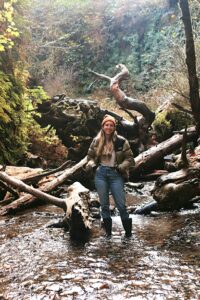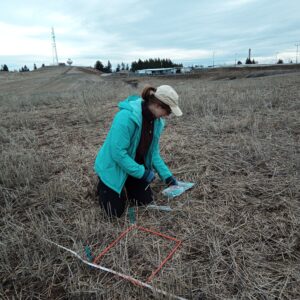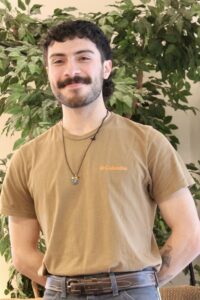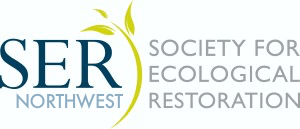Student Research Grants
This year SER NW awarded three student grants of $3,000 to support student research intended to improve restoration of natural systems within the greater Northwest ecoregion (WA, OR, AK, MT, ID, & Northern CA). Meet this year’s winners below!
Emily Cook

Project Title: Adaptive potential and plasticity of trait variation in annual prairie species across a PNW climate gradient: Consequences for changing climate and restoration
Emily Cook earned Bachelor of Science degrees in Environmental Science and Spatial Data Science from the University of Oregon in 2021, which laid the foundation for her journey into understanding the complexities of ecological systems. She is currently in her second year of pursuing a Ph.D. at the Institute of Ecology and Evolution at the University of Oregon. Emily’s research focuses on evolutionary and ecological dynamics that underpin the maintenance of biodiversity within plant communities and how plasticity within plant populations enables their persistence amidst rapidly changing climates, a critical aspect in the face of ongoing environmental challenges. She is fascinated by native wildflowers, partially due to her upbringing in the Pacific Northwest, which serves as a driving force behind her research endeavors. Emily is inspired by the breathtaking landscapes of this region’s prairies, and has directed her dissertation research towards understanding the intricate relationships between native prairie annuals and their environment.
Project Abstract:
Climate change and anthropogenic activities pose significant threats to global biological diversity and ecological services, necessitating ecological restoration efforts to protect plant ecosystems. The use of native plant species in restoration is essential, yet challenging, particularly in environments where locally adapted seeds are scarce or do not match rapidly changing climate conditions. In the face of these challenges, plasticity can be an important response to climate change, allowing rapid adjustments in phenotypic traits important for fitness. Where novel environments exceed plant tolerance and plasticity can no longer maintain fitness, genetic variation in plasticity may increase plants adaptive potential, allowing populations to persist. Few studies have investigated how plasticity and genetic variation varies among populations of co-occurring species.
To test for plasticity and genetic variation for plasticity in response to drought, this study employs a common garden and water exclusion experiment using 10 annual forbs prevalent in Pacific Northwest prairies. This research will track genotypes from 3 environmentally distinct populations of each species throughout the growing season in both drought and mesic environments and will estimate genetic variation and plasticity in traits associated with water availability and fitness. I predict that populations originating from higher inter-annual precipitation will exhibit elevated plasticity and genetic variation for plasticity in traits crucial for water usage. Changes in the local precipitation regime is predicted and may exceed the tolerance range of species in this region, potentially causing local extinctions. Thus, understanding plant plasticity and adaptive potential to drought becomes imperative in a restoration context.
April Hersey

Project Title: Forbs and Soil Biota: Bridging Prairie Restoration and Regenerative Agriculture with Compost Tea
April Hersey is a first-year master’s student co-advised by Dr. Robin O’Quinn and Dr. Justin Bastow in the Biology Department at Eastern Washington University. EWU is home to a 120-acre Inland Pacific Northwest prairie restoration site, where April’s research will bring together native plant restoration and regenerative agriculture techniques. Plant communities on prairie restoration sites are typically less diverse than those of prairie remnants, in part because of difficulty reestablishing forbs (non-grass herbaceous plants). April’s research focuses on whether restoring the soil microbial community on test plots on EWU’s restoration site improves the diversity of forbs that establish after seeding. To influence soil community composition, April will use compost tea: liquid compost extract amended with a microbe food source such as molasses and aerated to multiply the microorganisms from the source compost. April will document not only native plant abundance and biomass after compost tea treatment, but also soil bacteria, fungus, and nematode community composition before and after compost tea application. The results will show the extent to which compost tea changes the soil and plant communities on the restoration site. If this approach successfully increases forb diversity, it may be an inexpensive and scalable option for an integrated community ecology approach to ecosystem restoration.
Project Abstract:
The prairie ecosystems of the inland Pacific Northwest constitute an endangered ecosystem type that has been reduced and fragmented by conversion to agriculture. As in other prairie ecosystems, reestablishing diverse forbs (non-grass herbaceous plant species) has been challenging on inland northwest prairie restoration sites. Prior research has focused on adjusting factors such as forb-to-grass seeding ratios and disturbance regimes to improve native forb diversity in prairie restorations. However, there is growing interest in the role of soil microorganisms in prairie ecosystems, which may be crucial to successful restoration of the plant community. In my study, I will apply compost tea (liquid compost extract) to experimental plots on the prairie restoration site at Eastern Washington University to determine whether it improves native forb establishment. Compost tea is used in agriculture to improve crop yields and protect against pathogens, but it has not been widely studied in the context of ecosystem restoration. To enhance my results, I will compare the microbial composition of the compost tea I use with that of the soil community of the prairie restoration site before and after application to better understand its influence on soil community composition.
Ethan Torres

Project Title: Investigating the Effects of Mycorrhizal Inoculation in Native-Invasive Plant Interactions Post-Fire
Ethan Torres is a Mexican & Puerto Rican restoration ecology student from Oswego, IL. He attended undergrad at Marquette University in Milwaukee, WI- graduating in 2020 with a B.Sc. (Hons) in Biology. There, Ethan combined his long-time passion for environmental conservation with a growing interest in community ecology working as a part of the LaManna Lab. From 2019-2022 he worked with the LaManna lab at the H.J. Andrews Experimental Forest in Oregon’s western Cascades to study the effects of climate on plant density-dependence. There Ethan developed an interest in how plant-soil feedbacks can influence community dynamics and inform restoration practices. These interests drew him to becoming a master’s student at the University of Oregon, where he is currently a part of Dr. Lauren Hallett’s restoration ecology lab. Ethan’s current research brings him back to the H.J. Andrews, which experienced a wildfire that encompassed ~70% of the experimental forest in August of 2023, and now faces invasive species threats. Ethan’s thesis work seeks to uncover the ways mycorrhizal fungi can influence native and invasive plant interactions post-fire, with the goal of enhancing restoration success in recently burned landscapes. When Ethan is not tromping through old-growth forests, he enjoy spending time playing guitar and hockey, as well as sharpening his naturalist skills wherever he may be.
Project Abstract:
Landscapes across the Pacific Northwest are experiencing increasingly frequent and intense wildfires. Altered fire regimes drive changes in the composition of critical plant-soil mutualists such as mycorrhizal fungi. Mycorrhizae form mutualisms with plants that improve fitness, drive community succession, and potentially inhibit invasive species establishment. Mycorrhizal communities are prone to alteration once invasive species establish- preventing the reestablishment of native species post-fire. Inoculation of mycorrhizal fungi in post-fire landscapes may have significant restoration implications for mitigating invasive species spread and advancing native community succession, however few studies have examined this.
In 2023, the Lookout Fire burned through the H.J. Andrew’s Experimental Forest in western Oregon, which is mostly comprised of old-growth temperate-rainforest. Here I propose two experiments surrounding the Lookout Fire to assess whether mycorrhizal inoculation positively influences the competitive ability (H1) and community resistance (H2) of native plants (Elymus glaucus, Bromus corinatus, Achilliea millefolium) against invasive false brome (Brachypodium sylvaticum). To assess my first hypothesis, I will conduct a greenhouse competition experiment where native species will be grown with false brome under inoculated and non-inoculated conditions using soil from the Lookout Fire. To assess my second hypothesis, I will seed native species across burn severities in the H.J. Andrews- comparing the density of invasive species among inoculated and non-inoculated groups after one growing season. Should both hypotheses be supported, inoculated groups should improve competitively against, and experience lower densities of, false brome. These experiments have significant management implications regarding mitigating invasive species spread in a fire-dominated future.
The 2023 student grant application is closed for this year. Check back in the fall of 2024 for the next research grant opportunity!
Questions?
Please reach out to SER NW by email at sernw@ser.org
We look forward to supporting your research next year!

